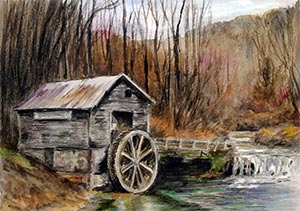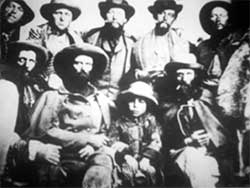The Little Thurston Girl ~ Index

The Little Thurston Girl has a name, and it was Rosie or Rosa Thurston. She was born at the end of November or the beginning of December, 1865. She was two years and five months old when she was stolen by the Indians on April 7th, 1868. Rosie was taken from Gardners Creek, where the old Mendon Mill was located. This grist mill provided the early settlers of the area a way to make flour, from their wheat. Otherwise they should be forced to travel to Brigham City or beyond to have their grain ground. The old Mendon Grist Mill was about three miles south of Mendon, towards Wellsville. It is located at what I call Darley's Barn, (since burned down) near the small ridge that sends the water from Gardner's Creek north towards Mendon. It is this natural flow of water that puts the mill in Mendon and not in Wellsville. Early Cache Valley towns more or less took up the land that was within their local drainage area.

The Indians at the time, had a great fascination for white children and they would take or steal them at most every chance they had. They, the white children, were a great curiosity to them. They would touch and poke at them with their fingers, rub their skin. Their skin was so, well white and soft. Nothing like the skin of the tribe that had stolen the child. A very fascinating event for all in the tribe who wished to examine the child, be it boy or girl. And of course being just small children, there was not much to worry about from them, so long as they were able to keep them hidden from the whites. The Indians at the time were what I would have to term, very different from the early settlers. They more or less held the thought that you were either dead, or alive. The time spent between these two events was, what ever happened to you happened to you. So while they might be good to the stolen children, in as not killing them, they were careless however as to what we might think in the care of them.
Being small children they would pickup the new, though much different foods, clothing and language. Many of the white children that were recovered over the years, were barely able to say a word of English. Some became so ingrained with the tribe they were in, that they did not want to go back to civilization, Indian life was all they knew. A few had to be watched, to see that they did not run away, back to the tribe. I suppose that one just becomes accustomed to whatever the environment is, that they grow up in .
Legends of the white Indian(s) are all too common (see: Elijah Nicholas Wilson) in the annuals of the American western movement. As noted, white children were very different and they felt a need to examine them, given a chance. Also the Indians had been stealing the children of other tribes for many years and selling them in the south to the Spanish and or the Mexicans. The term Peon comes from this period in time. Trafficking in humans was just another way to make ends meet, bad for you… good for me.
My Sorensen family history has it that Little Rosie Thurston was stolen by Pocatello's band of Indians, in direct retribution for the killing of an Indian in Mendon, sometime around 1866. Sagwitch confimred this sometime later to Peter Maughan, and also that she (Rosie) had died while in captivity.

Ruben Van Ornum was rescued from the local Shoshone Indians (Bear Hunter's group) over across the valley near Providence, Utah by Major Edward McGarry, part of the Second Cavalry, California Volunteers, on November 28th 1862. He was taken from the Utter wagon train (Utter Disaster) heading to Oregon, along the Old Oregon Trail. Reuben Van Ornum is the child shown here seated in the front middle, with his uncle, Zacheus Van Ornum, seated immediately to the left in this picture.
The other men were part of the Zacheus Van Ornum rescue group, that traveled down from Oregon to Utah to look for Reuben Van Ornum and perhaps other survivors of the massacre whom were rumorred to still be alive. They contacted Colonel P. Edward Conner for assistance, who had just established Camp Douglas, a month earlier on the bench above Salt Lake City. Ten of the forty-four members of this wagon train are said to have survived this sustained Indian attack, but in terible circumstances.
Zacheus Van Ornum is said to have been at the Battle of Bear River, on January 29th, 1863 in the employ of the army with the companies supply wagons. After the loss of his brother and most of his family, he wanted to see a just due paid, to the group of Shoshone Indians, whom he felt had murdered his brothers family. Although Bear Hunter's group had young Reuben Van Ornum, I suppose that the massacre was the deed of Pocatello's group of mixed Shoshone and Bannock Indians. As a note, Chief Washkie once ran with a group of the Bannock's when he was younger. However their cruelity was such that Washkie seperated himself from the band and traveled eastward to later become head chief of the Eastern Shonshone tribe.